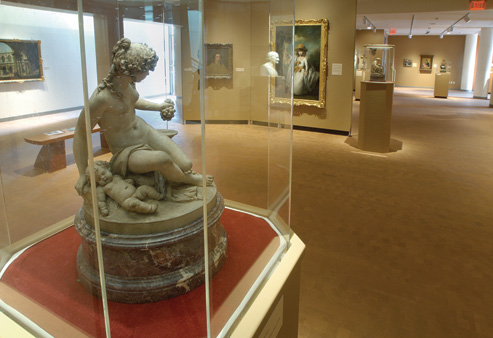Smith’s Museum
of Art: A Powerful Place
By Jessica Nicoll ’83
When I returned to Smith this past fall to become the
director and chief curator of the Smith College Museum of Art, it was with a very
personal understanding of the impact the museum and its collection can have on the
education of a Smith student. The opportunity to study directly from original works
of art—many of them the finest examples of their kind—had swayed my decision
to declare my major in art history and American studies during my sophomore year
at Smith in 1980. In studying the museum’s paintings, sculpture, prints, drawings
and photographs, I became curious about the nature of the institution that housed
those artworks and the kinds of work that took place within it. The Smith College
Museum of Art gave me my first behind-the-scenes glimpse at the world of museums
and started me on the path to my career as a curator and, now, director.
Now, in my brief time back at Smith I have learned
that I am not alone in having these associations. Most of the alumnae I have met
have strong memories of favorite artworks in the collection and speak of the intellectual
enrichment and spiritual sustenance that the museum provided them as students.
It is no coincidence that the museum and its collection
occupy a powerful place in the experience of Smith’s graduates. From its founding,
the college has had a visionary commitment to the importance of the arts in the curriculum.
The official circular for the college written in 1876 by Laurenus Clark Seelye, the
first president of Smith College, asserted that “the study of Art and Music
has been made…a part of the regular intellectual work of the College.” It
also announced the establishment of an Art Gallery where reproductions of masterworks
could be studied. Within three years Seelye had begun purchasing original paintings—chiefly
the work of contemporary American artists—establishing the foundation for the
museum’s collection. Seelye understood that the opportunity to explore an artwork
firsthand, to experience directly its scale, texture, composition and tonalities,
was essential to the study of both the history and practice of art. Smith College
took a progressive position in according the visual arts equal stature with more
traditional areas of study, giving them an unprecedented place in the American collegiate
curriculum.

That commitment has remained strong as evidenced not
only by the college’s exceptional academic programs but also by the continued
growth in scope and quality of the museum’s collection and the creation of
the new Brown Fine Arts Center. The museum today is a dramatically different institution
from the place I knew as a student, in the increased range of its offerings and in
its broad engagement with Smith’s community. No longer an exclusive resource
for the art department, our collection supports the pedagogy of faculty across campus.
In the current academic year, faculty in the departments
of chemistry, education and child study, French studies, and mathematics are using
the museum’s collections in their courses. The next 12 months will see collaborations
with the departments of landscape studies and engineering around two special exhibitions.
Each semester an average of 40 classes visit the Cunningham
Center for the Study of Prints, Drawings and Photographs to work directly with artworks
in the collection. And each year dozens of students seek out individualized learning
opportunities in the museum through special research projects, internships and participation
in our Student Museum Educator program in which students are trained to teach in
the galleries.
This interdisciplinary use of the museum’s collection
reflects a growing appreciation for the importance of visual literacy to successful
learning. As our understanding of different learning styles has expanded, so has
the recognition that learning in the arts has broader benefits to general cognition.
These include developing reasoning, imagination, descriptive ability and argumentation
skills while nurturing active engagement, disciplined and sustained attention, and
risk taking.
Further, the museum setting fosters experiential learning,
a highly effective method that involves participation and reflection on the part
of students. Students develop skills through experience, viewing art in the galleries
and gaining on-the-job training through internships.
Visual literacy and experiential learning have obvious
benefits to students of art, architecture and engineering, but there is compelling
evidence that these can also enhance the academic performance of students in virtually
every discipline. Beyond the academic realm, these methodologies equip students to
read images critically and think visually, skills that are crucial to negotiating
our image-saturated world.
Consistent with its progressive origins, the Smith
College Museum of Art has evolved in tandem with the college’s curriculum and
pedagogy. The museum’s new facilities in the Brown Fine Arts Center provide
galleries that showcase more of the permanent collection and that accommodate special
exhibitions, both large and small; four on-site classrooms; workspaces for students;
and common spaces such as the atrium. The museum strives to be a resource for all
Smith students, whether it is in helping to train them for a career in the arts or
to develop their capacity for thinking creatively in other disciplines.
In August Jessica Nicoll became director and chief curator of the Smith College
Museum of Art. She is the first Smith alumna to head the museum.
|























